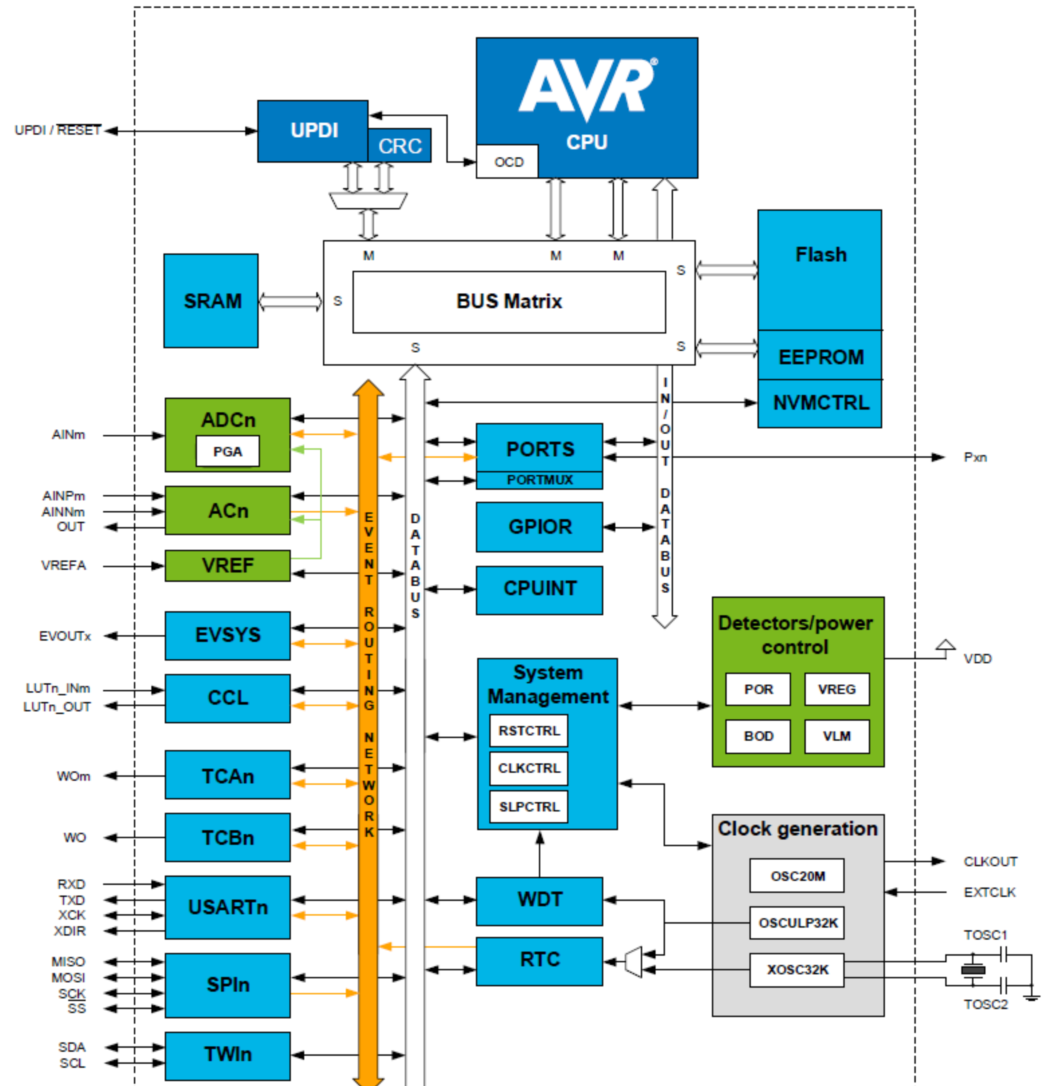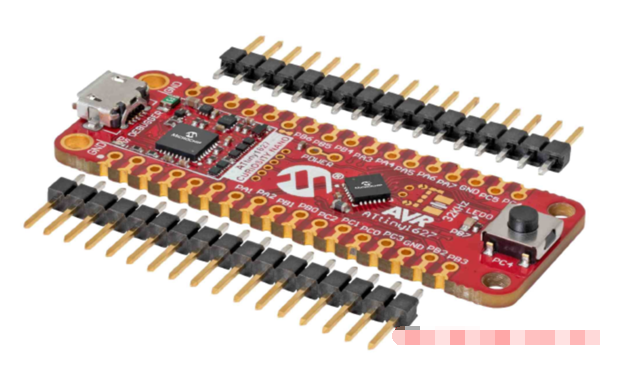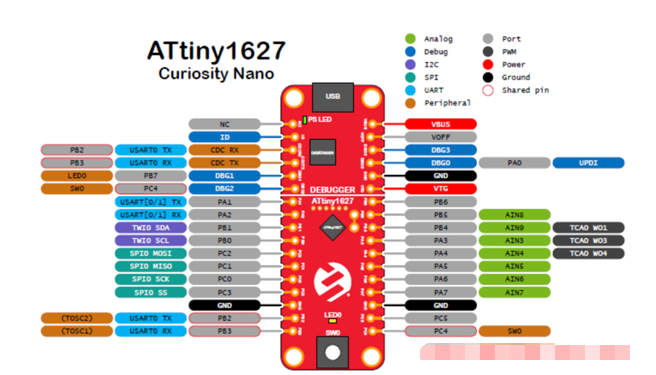Microchip ATtiny1624/ATtiny1626/ATtiny1627 8位MCU解决方案
 164
164
 拍明
拍明
原标题:Microchip ATtiny1627 8位MCU解决方案
microchip公司的ATtiny1624/1626/1627 8位微控制器(MCU),是tinyAVR® 2系列产品,采用AVR® CPU,其硬件乘法器运行高达20MHz,集成了16KB闪存,2JB SRAM和256B EEPROM,可采用14引脚,20引脚和24引脚封装.该器件采用Microchip的最新技术,具有灵活的低功耗架构,包括事件系统和睡眠运行(SleepWalkin),先进的数字外设和精确的模拟特性如带可编程增益放大器(PGA)的12位差分ADC.工作电压1.8V到 5.5V.器件具有多种内部基准源如1.024V, 2.048V, 2.500V, 4.096V和VDD.工作温度-40C - 85C (标准),可扩展至-40C - 125C .主要用在高精度传感器如烟雾,PIR,热电偶,湿度计,压力和力量传感器, 嘈杂环境的传感器,实时控制系统如电源转换器和二次安全监视.用于有限模拟性能的更大MCU/MPU的模拟接口芯片.本文介绍了ATtiny1627主要特性,框图和评估板ATtiny1627 Curiosity Nano(好奇纳米)主要特性,引脚图,电路图和PCB装配图.
The ATtiny1624/1626/1627 microcontrollers of the tinyAVR® 2 family are using the AVR® CPU with hardware multiplier, running at up to 20 MHz, with 16 KB Flash, 2 KB of SRAM, and 256B of EEPROM available in a 14-, 20-, and 24-pin package. The family uses the latest technologies from Microchip with a flexible and low-power architecture, including Event System and SleepWalking, advanced digital peripherals, and accurate analog features such as a 12-bit differential ADC with Programmable Gain Amplifier (PGA).
ATtiny1627主要特性:
• High-Performance Low-Power AVR® CPU
– Running at up to 20 MHz
– Single-cycle I/O access
– Two-level interrupt controller with vectored interrupts
– Two-cycle hardware multiplier
– Supply voltage range: 1.8V to 5.5V
• Memories
– 16 KB In-System self-programmable Flash memory
– 2 KB SRAM
– 256B EEPROM
– 32B of user row in nonvolatile memory that can keep data during chip-erase and be programmed while the device is locked
– Write/erase endurance
• Flash 10,000 cycles
• EEPROM 100,000 cycles
– Data retention: 40 years at 55C
• System
– Power-on Reset (POR)
– Brown-out Detection (BOD)
– Clock options
• Lockable 20 MHz Low-Power internal oscillator
• 32.768 kHz Ultra Low-Power (ULP) internal oscillator
• 32.768 kHz external crystal oscillator
• External clock input
– Single-pin Unified Program and Debug Interface (UPDI)
– Three sleep modes
• Idle with all peripherals running and immediate wake-up time
• Standby
– Configurable operation of selected peripherals
– SleepWalking peripherals
• Power-Down with full data retention
• Peripherals
– One 16-bit Timer/Counter type A (TCA) with a dedicated period register and three PWM channels
– Two 16-bit Timer/Counter type B (TCB) with input capture and simple PWM functionality
– One 16-bit Real-Time Counter (RTC) running from external 32.768 kHz crystal or internal 32.768 kHz ULP oscillator
– Two Universal Synchronous Asynchronous Receiver Transmitter (USART) with fractional baud rate generator, auto-baud, and start-of-frame detection
– Master/Slave Serial Peripheral Interface (SPI)
– Master/Slave Two-Wire Interface (TWI) with dual address match
• Standard mode (Sm, 100 kHz)
• Fast mode (Fm, 400 kHz)
• Fast mode plus (Fm+, 1 MHz)
– Event System for CPU independent and predictable inter-peripheral signaling
– Configurable Custom Logic (CCL) with four programmable Look-Up Tables (LUT)
– One Analog Comparator (AC) with scalable reference input
– One 12-bit differential 375 ksps Analog-to-Digital Converter (ADC) with Programmable Gain Amplifier (PGA) and up to 15 input channels
– Multiple internal voltage references
• 1.024V
• 2.048V
• 2.500V
• 4.096V
• VDD
– Automated Cyclic Redundancy Check (CRC) flash memory scan
– Watchdog Timer (WDT) with Window Mode, with a separate on-chip oscillator
– External interrupt on all general purpose pins
• I/O and Packages
– Up to 22 programmable I/O pins
– 14-pin
• SOIC150
• TSSOP
– 20-pin
• SOIC300
• SSOP
• VQFN 3x3 mm
– 24-pin
• VQFN 4x4 mm
• Temperature Ranges
– -40C to 85C (standard)
– -40C to 125C (extended)
• Speed Grades (-40C to 85C)
– 0-5 MHz @ 1.8V – 5.5V
– 0-10 MHz @ 2.7V – 5.5V
– 0-20 MHz @ 4.5V – 5.5V
• Speed Grades (-40C to 125C)
– 0-8 MHz @ 2.7V - 5.5V
– 0-16 MHz @ 4.5V - 5.5V
ATtiny1627应用:
• High-accuracy sensors: smoke, PIR, thermocouple, moisture, light, pressure, and force
• Sensors in noisy environments benefiting from noise suppression capabilities
• Real-time control systems such as power converters and secondary safety monitoring
• Analog interface chip for larger MCU/MPUs with limited analog performance

图1. ATtiny1627框图
评估板ATtiny1627 Curiosity Nano(好奇纳米)
The ATtiny1627 Curiosity Nano Evaluation Kit is a hardware platform to evaluate microcontrollers in the tinyAVR® 2-series. This board has the ATtiny1627 microcontroller (MCU) mounted.
Supported by Atmel Studio and Microchip MPLAB® X Integrated Development Environments (IDEs), the board provides easy access to the features of the ATtiny1627 to explore how to integrate the device into a custom design.
The Curiosity Nano series of evaluation boards include an on-board debugger. No external tools are necessary to program and debug the ATtiny1627.

图2. 评估板ATtiny1627 Curiosity Nano外形图

图3. 评估板ATtiny1627 Curiosity Nano元件分布图
评估板ATtiny1627 Curiosity Nano主要特性:
• ATtiny1627 Microcontroller
• One Yellow User LED
• One Mechanical User Switch
• Footprint for 32.768 kHz Crystal
• On-Board Debugger:
– Board identification in Atmel Studio/Microchip MPLAB® X IDE
– One green power and status LED
– Programming and debugging
– Virtual serial port (CDC)
– Two debug GPIO channels (DGI GPIO)
• USB Powered
• Adjustable Target Voltage:
– MIC5353 LDO regulator controlled by the on-board debugger
– 1.8-5.1V output voltage (limited by USB input voltage)
– 500 mA maximum output current (limited by ambient temperature and output voltage)

图4. 评估板ATtiny1627 Curiosity Nano引脚图
责任编辑:David
【免责声明】
1、本文内容、数据、图表等来源于网络引用或其他公开资料,版权归属原作者、原发表出处。若版权所有方对本文的引用持有异议,请联系拍明芯城(marketing@iczoom.com),本方将及时处理。
2、本文的引用仅供读者交流学习使用,不涉及商业目的。
3、本文内容仅代表作者观点,拍明芯城不对内容的准确性、可靠性或完整性提供明示或暗示的保证。读者阅读本文后做出的决定或行为,是基于自主意愿和独立判断做出的,请读者明确相关结果。
4、如需转载本方拥有版权的文章,请联系拍明芯城(marketing@iczoom.com)注明“转载原因”。未经允许私自转载拍明芯城将保留追究其法律责任的权利。
拍明芯城拥有对此声明的最终解释权。




 产品分类
产品分类















 2012- 2022 拍明芯城ICZOOM.com 版权所有 客服热线:400-693-8369 (9:00-18:00)
2012- 2022 拍明芯城ICZOOM.com 版权所有 客服热线:400-693-8369 (9:00-18:00)


